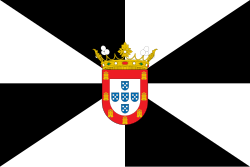Ceuta
Ceuta is a Spanish city in North Africa, at the Strait of Gibraltar which divides it from mainland Spain. It is an exclave of Spain, and is all surrounded by Morocco, which believes it should belong to them. Melilla is another such city. The city area is about 20 square kilometers, and there are over 82,000 people living in the city. The city is surrounded by a border fence, which has been built to keep the Moroccans (and other Africans) from moving there unlawfully. Until it became a self-governing city in 1995, it belonged to the Province of Cádiz.
|
سَبْتَة | |
|---|---|
| Ciudad Autónoma de Ceuta | |
 Location of Ceuta within Spain | |
| Coordinates: 35°53′18″N 5°18′56″W / 35.88833°N 5.31556°WCoordinates: 35°53′18″N 5°18′56″W / 35.88833°N 5.31556°W | |
| Country | |
| Autonomous city | Ceuta |
| Founded by | Carthaginians |
| Government | |
| • Type | Autonomous city |
| • Body | Council of Government |
| • Mayor-President | Juan Jesús Vivas (PP) |
| Area | |
| • Total | 18.5 km2 (7.1 sq mi) |
| • Land | 18.5 km2 (7.1 sq mi) |
| Elevation | 10 m (30 ft) |
| Highest elevation | 349 m (1,145 ft) |
| Population ()[1] | |
| Time zone | UTC+1 (CET) |
| • Summer (DST) | UTC+2 (CEST) |
It was built by the Phoenicians at a strategic position.
Ceuta Media
Phoenician archeological site, dated to the 7th century BC, next to the Cathedral of Ceuta
The Arab Baths of Ceuta, built between the 11th and 13th centuries
The Marinid Walls, built by order of Abu Sa'id Uthman II in 1328
Representation of Prince Henry the Navigator during the Conquest of Ceuta in azulejos at the São Bento railway station
The Royal Walls of Ceuta, built from 962 to the 18th century, and navigable moats
Eclectic House of the Dragons, built in 1905
References
Other websites
![]() Media related to Ceuta at Wikimedia Commons
Media related to Ceuta at Wikimedia Commons











